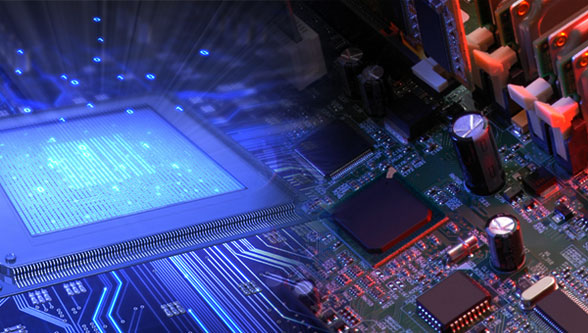When we purchase technology such as smartphones or even modern home appliances, we’re concerned with the functionality — but not always mindful of how it’s achieved behind the scenes. Or, in this case, under the stainless steel nameplate.
All consumers desire devices that are fast and secure, and that provide a satisfactory amount of memory, storage space and battery life. Because of this desire, semiconductor engineers are often faced with the tough task of developing technologies that enable these features in ever-smaller packages.
One technology, system on a chip (SoC), enables today’s mobile devices to go toe-to-toe with computers and laptops, and even beyond, functionality-wise. Let’s take a look at SoCs in greater detail below, plus what they mean for product design and the choices and options they present to designers.
What Is a System on a Chip (SoC)?
When we think of computers and laptops, we think of graphics-heavy applications, high processing power, support for peripherals, high-speed internet and lots of other functionality. But there are other devices now which offer many of these features plus many others. Smartphones deliver incredible graphics and even AR and VR experiences, and smartwatches blend instant connectivity with convenient health tracking and a variety of onboard sensors. We can now place a computer in our pocket whose functionality rivals even some of the priciest laptops.
As wearables mature, this miniaturization of processing power will continue in different form factors.
But what smartphones and wearables do not have is an abundance of surplus internal space. Building a personal computer as a hobbyist means purchasing a motherboard, RAM modules, graphics and audio cards and other components, and then arranging them inside a chassis, often with some room to spare for a cooling system or an extra fan.
But systems on a chip take all of this functionality, which used to be delivered by several discrete components, and put it on just one component instead. The space savings translate to smaller device footprints and larger batteries, meaning a more portable device that’s useful for longer.
Systems on a chip contain all or some of following structures:
- Central processing unit (single-core or multi-core CPU)
- Memory modules (RAM)
- Graphics architecture (GPU)
- Northbridge and southbridge
- Cellular radios (LTE, 5G connectivity, etc.)
- Radios for Wi-Fi, Bluetooth, GPS if needed
As a product designer’s or manufacturing company’s needs change, a semiconductor maker can add or remove these basic features to save on development costs. But as you can see, the end result is precisely what the phrase “system on a chip” suggests: a nearly self-contained computer module that can go on to become the backbone of any number of devices running any type of software we can dream of.
How Do SoCs Differ From Other Chips and Computing Processes?
Apple, Texas Instruments, Intel, Samsung, Qualcomm and NVIDIA all make their own SoCs. The differentiating factors between them come down to the number of cores, how well they manage power consumption and how well they support running multiple processes in parallel. The chief benefits of SoCs over other approaches is that SoCs use less power and are usually cheaper to incorporate than buying and installing each of the components and modules separately. But these companies are always finding ways to squeeze even more power into their chips.
The resulting competition has helped define and exemplify what SOCs are all about in the first place: the pursuit of powerful, high-efficiency, mobile-ready, all-in-one chips for devices designed to accompany us daily — and in some cases all day long. The fact that device makers don’t have to design around (or fret about compatibility between) separate power management components, sensors, memory units and CPUs means that the design and testing phases of product development can proceed much more smoothly and the resulting product can be as cleanly, economically and ergonomically designed as possible.
Where Are SoCs Most Beneficial?
In addition to smartphones and tablets, SoCs excel in another area too: the Internet of Things.
The IoT brings huge changes to how we live and conduct business and industrial activities. An IoT device is one which combines intelligence-gathering (sensors) with connectivity (wireless radios) and processing power (CPU). In other words, the IoT is an obvious place to put SoCs and their multiple talents to work.
The first reason SoCs are perfect for the IoT is because they provide security at the hardware level rather than the software level. To deploy SoCs in an IoT network is to daisy-chain together a bunch of devices with dedicated, circuit-level security processors. This processor blocks unauthorized access and performs encryption and decryption duties, all without the vulnerability of a software-level security platform handling those duties instead.
SoCs help make our designs smaller and more portable, thanks to having all the components consolidated onto a single substrate, and they make our devices more reliable and energy-efficient. In addition to tablets and phones, you can also find SoCs in data and cloud computing centers, connected appliances, vehicle guidance systems and even freight cartons, so shipping companies can track and gather data on time- or environment-sensitive merchandise in transit. Systems on a chip have also become indispensable in the design of rugged products as well as those destined for harsh climates and environments.
SoCs aren’t uniformly benefiticial, however. Product designers working on IoT projects have to consider the trade-offs between using a wireless system on a chip to achieve RF connectivity (including Wi-Fi and Bluetooth or Z-Wave and Zigbee for smart home products) or a dedicated RF module. The difference tends to come down to the level of experience of the company’s engineers, the desired time to market, and product batch sizes. SoCs are more complex than wireless modules, which means low-volume batches of products are a good fit for module-based design. They’re more expensive than using chips, but they cut out a lot of the potential problems related to design complexity — a consideration for less-experienced companies and engineers. Higher-volume production is better off using a chip-based design.
An additional consideration is that products on the RF spectrum usually require certification before they get to market. For the most part, ready-made RF modules will have had this step taken care of already, whereas companies taking the SoC route will have to absorb the cost of pursuing FCC certification and overcoming other approval barriers before getting their product to market.
The Future of SoCs and Product Design
And as they’re miniaturized further, we’ll probably see systems on chips incorporated into an even wider variety of consumer and commercial products. SoCs should be of interest to designers and engineers in a variety of fields and disciplines. As folks work to make these chips even smaller and more powerful, the question for the rest of us is: what are we going to build with them?
Article by —

Megan Ray Nichols
Freelance Science Writer
[email protected]
www.schooledbyscience.com/about
Read More Articles



